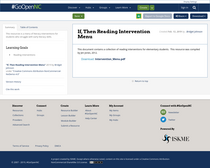Description
- Overview:
- This resources is a menu of literacy interventions for students who struggle with early literacy skills.
- Subject:
- Reading Foundation Skills
- Level:
- Lower Primary
- Material Type:
- Teaching/Learning Strategy
- Author:
- Bridget Johnson
- Date Added:
- 02/13/2019
- License:
-
Creative Commons Attribution Non-Commercial No Derivatives

- Language:
- English
- Media Format:
- Downloadable docs, Text/HTML
Comments
Standards
Evaluations
No evaluations yet.


This resource is very well organized. The intervention ideas are ones that a teacher is able to readily put into action. In some cases it would be good to know what certain achronyms stand for.
1. Full alignment to depth and breadth of standard(s) tagged - this is diagnostic list of interventions and assessments to support emergent readers.
2. Has clear learning objectives that are achievable through completion of this resource - the learning objectives support teachers with diagnosing targeted areas of instruction to master reading skills.
3. No assessment strategies have been indicated in the resource, so users should plan to add some type of assessment - this is an intervention menu for teachers once an assessment has been given to provide targeted instruction.
I appreciate how user-friendly this tool is!
1. The chart is fully aligned to the depth and breadth of standard RF.1.4 and partially aligned with standards RL.1.2 and RI.1.2 in the retelling and main idea sections as well as other overlapping first grade ELA standards.
2. Has some clear learning objectives broken down within the chart that are achievable by using the tool to make data-informed instructional decisions. The learning objectives are broken down and then phrased as negatives. "If the child is not meeting one of the objectives, here are some things to try." Some of the "then" activities are classroom adaptations, some are helpful assessment tools to dig deeper (PAST), and some are specific skill builders that can also be written as student-friendly I can statements.
3. No assessment strategies included for assessing if a child does meet the learning objectives after implementing the adaptations and interventions for a set period of time.
Strengths of this tool are that it is user-friendly and includes phonological awareness, phonics and word recognition, accuracy, fluency, vocabulary, and comprehension. It gives foundational reading teachers a decision guide on daily interventions based on the ways they see their readers struggling. An opportunity for improvement could be to incorporate more research-based intervention strategies and include assessment tools.
This is partially aligned to the standard, as well as partially aligned to other ELA standards.
This particular resource is more for the teachers and not the kids. While this document does contain activity ideas you can use with the kids, it doesn't give clear learning objectives. This resource provides the teacher with a list of ideas on how they can help their scholars if/when they present difficulty in a specific area.
The assessments are more informal than summative.
Karen, I agree with you that this resource is a teaching tool that partially covers many standards. It could be expanded and directly linked to each 1st grade standard with remediation activity ideas.
This is a good resource to use of Tier planning when looking at your child and what they can and cannot do.